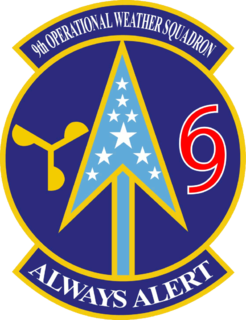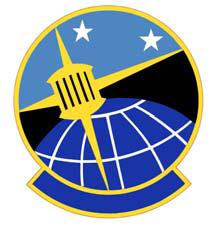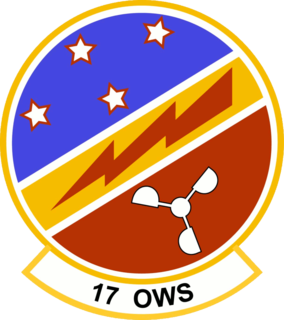
Kadena Air Base is a United States Air Force base in the towns of Kadena and Chatan and the city of Okinawa, in Okinawa Prefecture, Japan. It is often referred to as the "Keystone of the Pacific". Kadena Air Base is home to the USAF's 18th Wing, the 353rd Special Operations Group, reconnaissance units, 1st Battalion, 1st Air Defense Artillery Regiment, and a variety of associated units. Over 20,000 American servicemembers, family members, and Japanese employees live or work aboard Kadena Air Base. It is the largest and most active US Air Force base in East Asia.

The 557th Weather Wing is a United States Air Force formation and its lead military meteorology center. It delivers environmental situational awareness worldwide to the Air Force, the Army, joint warfighters, Unified Combatant Commands, the national intelligence community, and the Secretary of Defense. It is headquartered at Offutt Air Force Base, in Bellevue, Nebraska.

The 376th Air Expeditionary Wing is an inactive wing of the United States Air Force. It was last stationed at the Transit Center at Manas International Airport, Kyrgyz Republic, supporting U.S. and ISAF operations in Afghanistan.

The 1st Weather Group is a group of the United States Air Force. It oversees all six operational weather squadrons; the 15th OWS at Scott AFB, Ill.; the 17th OWS at Joint Base Pearl Harbor–Hickam, Hawaii; the 21st OWS at Kapaun Air Station, Germany; the 25th OWS at Davis-Monthan AFB, Ariz.; the 26th OWS at Barksdale AFB, La.; and the 28th OWS at Shaw AFB, SC. The 1st WXG is a subordinate of the 557th Weather Wing.

The 9th Operational Weather Squadron, based out of Shaw AFB, SC, was the Squadron responsible for weather prediction in the Southeastern United States. It was split from the 28th Operational Weather Squadron in 2006. The 9 OWS inactivated on 31 May 2008 and merged with the 26th Operational Weather Squadron located on Barksdale AFB, Louisiana.

The 25th Operational Weather Squadron, based out of Davis-Monthan AFB, AZ, is the Squadron responsible for the Western United States; the current states in the Area of Responsibility (AoR) are Arizona, California, Colorado, Idaho, Montana, Nevada, New Mexico, Oregon, Utah, Washington, and Wyoming.

The 26th Operational Weather Squadron (26OWS), based out of Barksdale Air Force Base, Louisiana, is the US Air Force meteorological squadron responsible for the Southeastern United States. The current states in the Area of Responsibility (AOR) include Kansas, Missouri, Oklahoma, Arkansas, Texas, Louisiana, Mississippi, Tennessee, Alabama, Georgia, Florida, and the Carolinas.

The 28th Operational Weather Squadron, is an operational weather squadron responsible for supporting USCENTCOM operations.

The 21st Operational Weather Squadron provides weather support for all US Air Force and Army in the European and Africa Commands and is based at Kapaun Air Station, Germany.

The 11th Operational Weather Squadron (11OWS) was an operational weather squadron of the United States Air Force. The squadron was based out of Elmendorf AFB, Alaska, and was responsible for forecasting Alaska's weather and analyzing its climate.

The 20th Operational Weather Squadron which provided forecasts for the Air Force and Army in Japan and South Korea, is now inactive following the transfer of its mission to Hickam Air Force Base, Hawaii on April 17, 2006.

The 17th Operational Weather Squadron is a unit of the military of the United States. Based at Hickam Air Force Base in Hawaii, it covers weather for the largest geographical area in the world.

The 22d Operations Group is the operational flying component of the United States Air Force 22d Air Refueling Wing. It is stationed at McConnell Air Force Base, Kansas, and is part of Air Mobility Command (AMC)'s Eighteenth Air Force.

The 346th Bombardment Group is a former United States Army Air Forces unit. It was last assigned to the 316th Bombardment Wing at Kadena Airfield, Okinawa, where it was inactivated on 30 June 1946. The group was originally a heavy bomber training unit, but was inactivated in a general reorganization of Army Air Forces training units in 1944. It was reorganized as a Boeing B-29 Superfortress group later that year. It moved to Okinawa in 1945, but arrived too late to participate in combat.

The 2d Systems Operations Squadron, stationed at Offutt Air Force Base, Nebraska, delivers global environmental intelligence products and services for the defense of the United States of America and its global interests through the 24 × 7 operation, sustainment and maintenance of Air Force Weather's strategic center computer complex, production network, and applications.

The 2nd Weather Squadron, headquartered at Offutt Air Force Base, Neb., continuously supports Joint warfighters and Department of Defense decision-makers, including the intelligence community and space operators with accurate, relevant, timely and specialized global terrestrial and space observations, analyses, forecasts and alerts.

The 435th Bombardment Squadron, also known as the "Kangaroo" Squadron, is an inactive United States Air Force unit. It was last assigned to the Eighth Air Force 333d Bombardment Group, based at Kadena Air Base, Okinawa. It was inactivated on 28 May 1946.

The 307th Operations Group is an Air Reserve Component of the United States Air Force. It is assigned to the 307th Bomb Wing, Air Force Reserve Command, stationed at Barksdale Air Force Base, Louisiana.

The 32d Air Expeditionary Group is a provisional unit of the United States Air Force (USAF). It is assigned to United States Air Forces in Europe (USAFE) to activate or inactivate at any time. It was last active as the 32d Air And Space Operations Center in December 2006 at Ramstein Air Base, Germany.

The 623d Air Control Squadron is an operational unit of the United States Air Force assigned to the 18th Wing. The 623d is based out of Kadena Air Base, Okinawa, Japan. The 623d is tasked to provide Command & Control within a sector of the Japanese Air Defense System. The 623d conducts operations out of Japanese Air Self Defense Force facilities located at Naha Air Base, Kasuga Air Base and Iruma Air Base. The 623d operates the Southwest Sector Interface Control Cell, conducting joint and bilateral tactical datalink operations.




















